Abstract
The influence of temperature on soil behavior has traditionally attracted attention for geotechnical engineers, especially in the design of engineering works and nuclear facilities located in regions with severe cold climates. This research emphasizes exploring how temperature variations affect essential soil properties that are significant for the resilience and long-term stability of geotechnical structures. For this reason, the influence of temperature on the soil’s mechanical and physical attributes was comprehensively evaluated. To achieve this, soil mixtures consisting of two blends prepared as 70% bentonite with 30% sand and 70% sand with 30% bentonite (70B30S and 70S30B) were exposed to temperatures ranging from –45 °C to +105 °C for durations of 24 and 48 h. The study examined how temperature variations affect the mechanical, physical, and mineralogical features of soil through consistency limit tests, direct shear tests, swelling pressure tests, and X-ray diffraction (XRD) analysis. It was observed that the internal friction angle (Φ) declined as temperature increased in both mixtures, particularly in specimens with higher sand content. Similarly, cohesion (c) values decreased with increasing temperature, more significantly in mixtures with higher bentonite content. Additionally, the consistency limits and swelling pressure decreased as temperature rose. This trend was evident in both mixtures. Swelling pressure results showed that from 20 °C to 105 °C, the pressure rose with temperature in bentonite-rich soils, while it decreased in sand-rich soils. Conversely, at subzero conditions (–10 to –45 °C), swelling pressure increased as temperature decreased in mixtures dominated by bentonite, while it dropped in those rich in sand.
1. Introduction
Thermal influence represents a pivotal factor capable of instigating notable alterations on the soil’s mechanical and physical characteristics. Throughout history, there has been a notable interest in how heat affects soil, either thermo-mechanical strengthening or weakening. Such focus is particularly important in various geotechnical applications, such as geostructure projects that introduce changes in soil temperature. In this context, a comprehensive comprehension of the effects of temperature fluctuations on soil behavior and properties is of paramount importance. Within geotechnical engineering, grasping these effects is essential to understand the shearing characteristics of soil and how thermal conditions influence these properties. This understanding is essential to ensure the stability and dependability of geotechnical projects exposed to different thermal variations. Throughout the annals of history, geotechnical engineers have harbored enduring apprehensions regarding the repercussions of temperature fluctuations on soil behavior. This concern is particularly pronounced in diverse geotechnical applications, such as the disposal of high-level nuclear waste [1], thermal storage systems [2], geostructures for energy [3], high-voltage buried cable networks [4], and CO2 sequestration plants [5]. On the other hand, frost conditions that occur in cold climates have a significant impact on the durability and performance of earthwork projects, including road construction projects [6].
The exploration of temperature effects on soils has evolved significantly since Gray’s initial experiments in 1936, which focused on the temperature ranges of 10 °C and 20 °C. The first conference dedicated to soil temperature-related matters in Washington, USA, in 1969 marked a pivotal moment in this field, highlighting the growing interest in understanding how temperature influences soil behavior. Early studies were primarily constrained to a temperature range of 10–50 °C, largely driven by researchers’ interests in elucidating the temperature differentials between field samples and controlled laboratory conditions [7]. As the field has progressed, technological advances have led to a revolution within geotechnical engineering, particularly rock- soil mechanics and geological sciences. These technological advances have enabled researchers to conduct in-depth studies on how low and high temperature conditions influence the mechanical and physical attributes of soils. For example, contemporary studies have shown that temperature changes can significantly affect soil properties such as tensile strength, compressive strength, and swelling behavior [8,9,10,11,12,13]. Over the past few decades, extensive research has been carried out on how soils respond to thermal effects [14,15,16,17,18]. The outcomes of numerous laboratory investigations conducted on diverse soil samples subjected to elevated temperatures or freezing conditions illustrate a direct correlation between soil’s mechanical and physical attributes such as tensile strength, compressive strength, and swelling and temperature variations. It is also worth noting that the temperature-dependent properties can vary depending on the soil type [19,20,21]. However, more research is still needed regarding how temperature variations affect the mechanical and physical behavior of soils. Azhar et al. [22] conclude that temperature changes significantly affect soil cohesion and Φ, primarily through mechanisms such as decreased water viscosity and weakening of interparticle bonds. However, the effects of extreme temperature ranges on soil mixtures with different properties, such as clay–sand mixtures, have still not been sufficiently investigated. The present work seeks to fill this gap through an investigation of the coupled thermal and mechanical response of bentonite–sand mixtures mixtures over a wide temperature spectrum (−45 °C to +105 °C).
Clay soils possess characteristics such as reducing seepage, heat insulation, contamination mitigation, and protection from ration, which render them potentially advantageous for geotechnical purposes demanding significant thermal loads, such as nuclear waste containment [23,24,25]. Furthermore, the occurrence of chemical reactions within waste materials can lead to temperature fluctuations in the soil of up to 105 °C. Given the significance of soil response to temperature variations, numerous researchers have dedicated efforts to this field in order to enhance the design of long-term disposal sites with improved safety measures. Studies on high-level nuclear waste management in France and Spain provide remarkable results for improving safety measures in this area [26,27,28,29]. Soil structure can change significantly, especially after freezing temperatures. This is because fine particles tend to group together, and coarse particles break apart. Many studies have looked into how freezing temperatures affect the mechanical and physical characteristics of soil [30,31,32]. Repeated freeze–thaw (F-T) cycles cause pore volume to decrease in loose soils and to rise in thick soils, according to research by [33]. In compacted soils, seasonal F-T cycles can enhance soil structure and reduce soil penetration resistance. Furthermore, nothing is known about the continuing influence of F-T cycles on soil aggregate stability. Though research is conducted on how F-T cycles affect the growth and dynamics of soil pore structure, little is known about how they affect the modifications of soil characteristics that occur during F-T activity.
In general, temperature impacts on soil can be attributed to two main sources: high temperatures emanating from subsurface heat sources or low temps resulting from seasonal variations in frozen ground. Presently, various projects such as nuclear waste repositories, heat storage facilities, energy-related soil structures, underground power lines, and petroleum recovery operations operations subject soils to extreme temperatures, sometimes exceeding 100 °C. These elevated temperatures significantly alter the geomechanical properties of soils. Conversely, when exposed to freezing conditions, soil often undergoes a transformation, becoming highly resilient and nearly impervious. Consequently, artificial ground ground freezing is occasionally applied to provide short-term stabilization of soils in foundation works, retaining walls, underground tunnel structures, and other projects involving poor soils. Hence, researchers are investigating potential changes in these properties due to temperature fluctuations. Some studies state that temperature changes associated with environmental conditions can trigger landslides due to the thermal effects they create on the ground [34,35,36,37]. Donna et al. [38] investigated the thermal effects on piles by subjecting clay, sand, and clay–concrete interfaces to temperatures of 20, 50, and 60 °C. Their experimental findings revealed that the interfacial adhesion of clay soils increased with temperature, while friction decreased with rising temps. Conversely, sand–concrete interfaces remained unaffected by temperature changes. In contrast, Yazdani el al. [39] reported conflicting results, suggesting a reduction in interfacial adhesion when the temperature rose by 10 °C (from 24 °C to 34 °C). Yavari et al. [40] observed negligible effects on both clay and sand–concrete interfaces.
Studies on thermal effects typically employ two different approaches: the direct testing of samples under predetermined temperatures, and the gradual heating or cooling of samples followed by testing at room temperature. This study adopts both approaches. In this section, a review of previous research investigating bentonite–sand mixture (BSM), as utilized in this study, along with other soil mixtures subjected to heated or cooled conditions, is provided. Temperature can profoundly influence the mechanical and physical properties of soil through various mechanisms, including alterations within the soil–water cycle, changes in soil particle characteristics, and modifications in pore water dynamics. The following sections will discuss the influence of temp on various physical and mechanical attributes of soil, as well as potential alterations in these properties due to temperature variations.
Variations in shear strength in reaction to temperature fluctuations constitute a crucial aspect of soil behavior, particularly in the design of structures sensitive to temperature changes. The effect of heat on soil shear strength has attracted the attention of several studies, indicating the continued interest of scholars in this area due to its importance. Cekerevac et al. [41] conducted drained triaxial shear tests on kaolin clay under different overconsolidation ratios (OCRs) at 20 °C and 90 °C. Their findings indicated that the shear strength of specimens increased with higher temperatures across all the OCR values. Furthermore, they examined how temperature variations affect the Critical State Line (CSL) and concluded that temperature variations had no significant impact on the CSL. Abuel-Naga et al. [42] utilized triaxial equipment to investigate the undrained shear strength of soft Bangkok clay under continuous and cyclic thermal conditions while varying the overconsolidation ratio (OCR). Their findings indicated that undrained shear strength consistently increased with rising temperature across all the OCR values, with cyclic heating proving more effective in enhancing strength compared to constant heating. Additionally, specimens subjected to cyclic heating demonstrated lower axial strain at peak deviatoric stress than those under continuous heating. In a complementary context, Zhang et al. [43] explored the shear strength behavior of overconsolidated Callovo-Oxfordian and Opalinus clay rocks under temperature variations, highlighting material-specific responses. Extending this line of inquiry, Zhang et al. [44] conducted triaxial undrained shear tests on Boom clay and found that raising the temperature from 20 °C to 80 °C led to a significant reduction in shear strength (30–40%). Interestingly, this behavior contrasts with the response of soft Bangkok clay, which exhibited strength enhancement under similar thermal conditions.
On clay soil specimens, Cekerevac and Laloui [41] conducted cyclic triaxial tests under controlled temperature conditions. After the specimens were consolidated at 600 kPa and subjected to heating up to 90 °C, they underwent cyclic undrained shearing under drained conditions. Interestingly, they found that axial elongation and pore pressure remained almost identical regardless of whether the first cycle was performed at room temperature or at high temperature. On the other hand, a decrease in elongation along with pore water pressure observed in each cycle was observed within the thermally treated specimens during the successive shear cycles. This was explained by the clay’s densification during drained heating. Additionally, the heated samples exhibited an increased number of cycles to failure, with slightly lower pore pressure compared to unheated samples.
Based on the studies conducted by [40,45], there appears to be inconsistency in the reported effects of temperature influence on the shear characteristics of fine-grained soils. Yavari et al. [40] utilized a direct shear device with temperature control to examine the impact of heating conditions on clay’s internal Φ and concluded that Φ remained largely unaffected by temperature variations. Conversely, Yu et al. [45] employed a modified triaxial test on Boom clay and observed a significant reduction in shear strength, with decreases of up to 30–40% as temperature increased. These contradictory findings may stem from differences in the soil types examined, testing protocols, or temperature ranges applied. To provide a broader perspective, Figure 1a illustrates the temperature independence of Φ across various fine-grained soils reported in the literature [18]. This figure consolidates insights from multiple studies, highlighting that while certain soil types exhibit negligible changes in Φ with temperature, others may show notable variations depending on specific conditions such as particle composition, mineralogical characteristics, and the applied temperature range. Such discrepancies underscore the need for standardized testing methodologies to ensure consistent interpretations of temperature effects on soil behavior. Yu et al. [45], Xio et al. [46], and Yavari et al. [40] analyzed how temperature variations affect the cohesion response of clayey soils. In the study conducted by [40], it was determined that temperature increases between 5 and 40 °C in kaolin clay caused both an increase and a reduction in soil cohesion. However, findings indicated that cohesion declined toward the conclusion of the heating stage. Conversely, tests by [45], showed that Boom clay exhibited a notable 30–40% reduction in cohesion as the temperature rose from 20 °C to 80 °C. These findings demonstrate that the behavior of various soil types under thermal fluctuations may vary and that factors such as test equipment, material properties, and thermal gradient play a critical role in these evaluations. Xio et al. [46] showed that typical thermal conditions corresponding to ambient temperature led to a slight decrease in Φ by one degree. However, heating and cooling cycles led to a significant increase in Φ by about 4 to 5. In addition, both normal and cooling cycles led to a slight decrease in interfacial cohesion of about 0.6 kPa. While normal specimen heating caused a reduction of 6 kPa in the c of the interface, after 10 heating cycles, there was an increase in interface cohesion of approximately 4 kPa compared to its initial value. Overall, the findings regarding Φ and c under normal heating conditions are largely consistent with those reported by other researchers. When the relationship between temperature and cohesion is evaluated with the help of the data obtained from the literature, it is possible to interpret that the cohesion of fine-grained soils decreases as the temperature increases (Figure 1b).
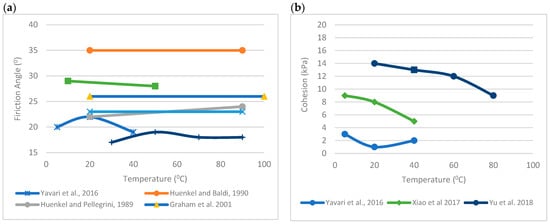
Figure 1.
(a) Effect of temperature change on Φ. (b) Effect of temperature change on cohesion (c) (Huenkel and Pellegrini, 1989 [47]; Huenkel and Baldi, 1990 [48]; Graham et al., 2001 [49]; Yavari et al, 2016 [40]; Xiao et al., 2017 [46]; Yu et al., 2018 [45]) Adapted from open access journal ref. [18].
The general evaluation of the studies leads to the conclusion that an increase in temperature generally has no significant influence on Φ. Φ is primarily determined by particle size and shape, which are only minimally affected by temperature changes. However, cohesion is highly dependent on the deformability of coarse-grained soils and, more importantly, the interplay between water and clay particles, accounting for interlayer thickness and the viscosity–shear resistance of clay minerals. Increased temperatures are thought to affect these properties and result in a decrease in the viscosity–shear resistance of clay minerals, thereby lowering cohesion. It has also been observed that cyclic temperature variations can increase both c and Φ. The reorganization of the particles during the temperature repeated temperature cycles, contributing to a denser structure and higher shear parameters, could be the cause of these phenomena.
Researchers have also investigated direct permeability measurements at different temperatures [50]. Sultan et al. [51] employed a constant-head permeability test to assess the hydraulic conductivity of Boom clay under different temperature conditions. The findings revealed that permeability increased under continuous effective stress due to thermal loading, followed by a decline during cooling phases. Additionally, Abuel-Naga et al. [42] attributed changes in permeability caused by temperature variations to alterations in water viscosity. The liquid limit (LL), a pivotal indicator for categorizing fine-grained soils, is widely acknowledged for its importance in assessing mechanical properties such as shear strength, swelling potential, and compressibility. Numerous studies have reported a decrease in LL of various clay soils as temperatures increased. Given that LL serves as an indirect measure of strength, Campanella, and Mitchell [8] suggested that these findings align with the observed strength reductions in clays under high temperatures. In the presence of elevated temperatures, there was less consistency observed with the plastic limit (PL). Youssef et al. [52] and Ctori [53] conducted tests between 15 and 35 °C and 6 and 35 °C, respectively, and both reported a decrease in the water content at the LL at higher temperatures. Beles and Stanculescu [54] together with other researchers, emphasized that the consistency limits are influenced by temperature, and the extent of this effect depends on the soil type, with the LL and plasticity index (PI) being more sensitive to thermal fluctuations compared to the plastic limit (PL).
For clays primarily composed of kaolin, the consistency indices are unlikely to change significantly at temperatures up to 400 °C. However, soils containing bentonite as the predominant component tend to experience considerable decreases in the liquid limit (LL) and PI with increasing temperature [55]. The consistency limits for kaolin and bentonite are observed to vary with temperature. Research findings indicate that the impact of temperature is minimal within the range of 100 °C to 200 °C. Kuntiwattanakul et al. [56] also reported similar observations for temperatures ranging from 22 °C to 200 °C. In contrast, Zhang et al. [57] observed that the LL and PL of clay decreased when subjected to heating from 14° Celsius to 35° Celsius.
As seen in the studies mentioned in the text, depending upon the thermal condition of the ground, the soil is sensitive to changes in surface temperature [58]. A large number of engineers with geotechnical expertise are concerned with frost heaving and thawing in cold climates. Also, due to the phenomena caused by human activities and global warming, many problems are encountered regarding the stability of embankments. In this context, the aim of this study is to study the mechanical and physical properties of the soil and the changes possible in these properties due to temperature changes. Understanding these changes is vital for comprehending the advantages and limitations associated with different environmental conditions and for ensuring the safety and reliability of structures designed to endure temperature variations. To address these objectives, the study followed the outlined methodology depicted in Figure 2.
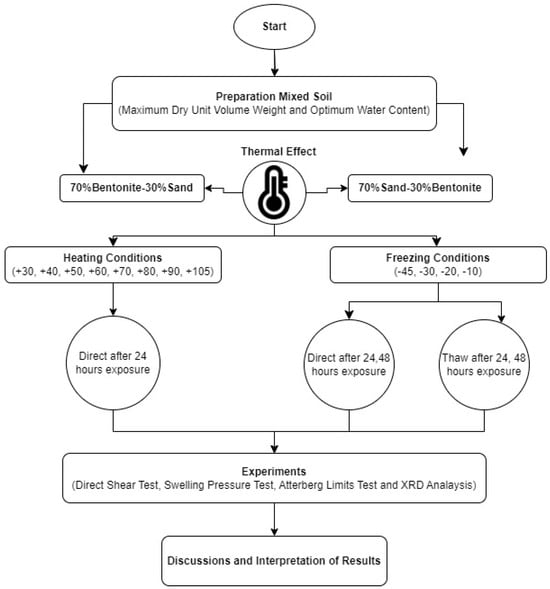
Figure 2.
Mind-map of study stages.
2. Material and Method
In this study, two distinct soil types—sand and bentonite—were employed for experimental investigations. Soil mixtures were systematically prepared in a controlled laboratory environment to ensure uniformity in the properties of all the samples. Initially, the optimum water content and consistency limit values of the pure soil samples were determined using the mass retained on a No. 08 sieve, which facilitated the formulation of specific test mixtures, namely 70B30S and 70S30B. Each soil mixture was compacted at its respective optimum water content and subsequently subjected to a series of eleven thermal temperatures, ranging from −45°C to +105°C, including the intermediate values of −30°C, −20°C, −10°C, +30°C, +40°C, +50°C, +60°C, +70°C, and +80°C. Following the thermal exposure, a comprehensive suite of tests was conducted, including consistency limit assessments, swell pressure experiments, and shear box tests, adhering to the established standards for soil testing. The parameters evaluated in this research encompassed the c, Φ, shear strength, consistency limits, and swelling pressure values of the soil mixtures. Furthermore, representative samples from all the mixtures were subjected to XRD analysis to elucidate the mineralogical composition and structural characteristics of the soils. The comparative performance analysis of the materials utilized in this study is thoroughly discussed in the Section 3, highlighting the implications of thermal variations on soil behavior.
The bentonite employed in this study was obtained from KarBen Inc. (Tokat, Turkey). Prior to use, the raw material was sieved through a 40-mesh screen to remove coarse particles (Figure 3a). The main physical and chemical properties of the bentonite are presented in Table 1. This clay mineral is soft, easily disperses in water, and exhibits a greasy texture when moist. It has a high capacity for water uptake and swelling due to its extremely fine crystal structure and large specific surface area [59]. Bentonite originates from the alteration of volcanic materials such as ash, tuff, and lava, and is typically rich in aluminum and magnesium compounds. In this research, sand was supplied from a local construction company in Safranbolu, Karabük. The material was washed, oven-dried, and passed through a No. 40 sieve prior to testing (Figure 3b). Grain size distributions for the mixtures of 70% clay + 30% sand (70C30S) and 70% sand + 30% clay (70S30C) are presented in Figure 3c. Based on Standard Proctor tests (Figure 4a,b), the maximum dry unit weight and corresponding optimum water content of the 70C30S mixture were determined as 13.8 kN/m3 and 27%, respectively. For the 70S30C mixture, the maximum dry unit weight was 16.9 kN/m3, and the optimum water content was 20%. In addition, the pure sand and pure bentonite used in the experiments were characterized by XRD analyses, while the particle size distributions of the mixtures are illustrated in Figure 5a,b.
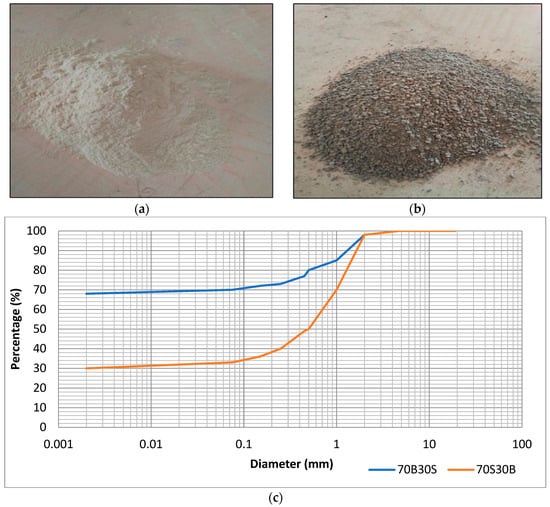
Figure 3.
Bentonite (a), sand (b), and sieve analysis of 70B30S and 70S30B (c).

Table 1.
Physico-chemical characteristics of the bentonite sample.
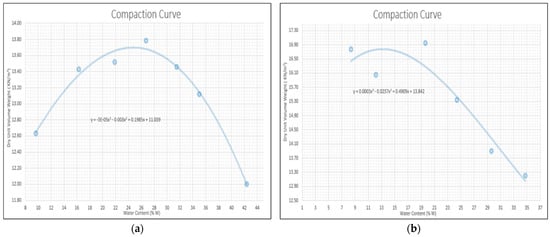
Figure 4.
Compaction curve of 70B30S (a) and compaction curve of 70S30B (b).
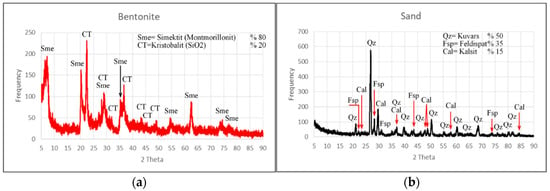
Figure 5.
XRD patterns of (a) natural bentonite and (b) unheated sand specimens.
The prepared samples underwent curing under two distinct thermal conditions.
- I.
- Freezing Conditions: The soil samples were securely wrapped and placed within a freezing chamber for a specified duration, maintaining a constant temperature as outlined in the test protocols provided in Figure 2. Following this, the soil samples were applied to swelling pressure tests, box shear tests, and consistency limit tests.
- II.
- Heating Conditions: The soil samples were carefully wrapped and placed within a laboratory oven chamber for a duration of 24 and 48 h, maintaining a constant temperature as specified by the test protocols provided in Figure 2. Subsequently, the soil samples underwent swelling pressure tests, box shear tests, and consistency limit tests.
Maintaining a consistent water content in the samples throughout the experiment is crucial. To ensure this, all the specimens were sealed with aluminum foil and enclosed in kiln bags before being placed in the laboratory kiln for the duration specified.
3. Findings and Discussions
3.1. Atterberg Limit
Determination of soil consistency parameters is very important for effective geotechnical design. This is especially true for ensuring the structural integrity and safety of underground structures exposed to thermal loads and temperature fluctuations. The LL, PL and plasticity index (IP) values of soils also affect the assessment of the shrinkage and swelling potential of soils, which can significantly affect the performance of geotechnical structures. In this study, the LL and PL values for both pure bentonite and bentonite–sand mixtures were determined under ambient conditions as documented in Table 2. These basic data are critical to understanding the natural properties of soil mixtures before any thermal exposure. Furthermore, it is imperative to investigate how temperature changes affect these consistency parameters, as such changes can alter the mechanical behavior of the soil. For this purpose, the effects of heating on consistency limits were systematically analyzed and the results are presented in Table 3. This table provides valuable information on the thermal sensitivity of soil mixtures by showing the changes within the consistency limits under high-temperature conditions. Understanding these thermal effects is crucial for predicting soil behavior in real-world applications, especially in scenarios where temperature fluctuations are common. The findings highlight the importance of incorporating temperature-dependent soil properties into geotechnical design considerations, thereby improving the durability and reliability of underground structures.

Table 2.
Consistency limit values measured under ambient conditions without thermal influence (laboratory temperature (20–24 °C)).

Table 3.
The results obtained from consistency limit tests conducted under various conditions.
When Figure 6a,b and Table 3 are analyzed, it is seen that the consistency limits of bentonite–sand mixtures (BSMs) show significant changes in different temperature ranges ranging from −10 °C to +105 °C. The findings show that there is a general decrease in the liquid limit (LL) and plastic limit (PL) values as the temperature increases. In particular, LL decreased by approximately 31% for 70B30S and 27% for 70S30B, while PL decreased by 25% and 19% for the same mixtures, respectively. This decrease is more pronounced in the LL values compared to PL, reflecting the inherent sensitivity of the liquid limit to thermal changes. Under freezing conditions, an opposite trend was observed. The LL values increased by approximately 38% for 70B30S and 41% for 70S30B, while PL increased by 17% and 13%, respectively. These increases can be explained by the structural rearrangement of soil particles under freezing temperatures, where finer particles aggregate and coarser particles break up, leading to water redistribution within the soil matrix. Interestingly, the rate of increase in the PL values during freezing was faster than that observed for the LL values, suggesting that it reflects the relative stability of plasticity under changing temperature conditions. Consistency limit tests conducted under both heating and freezing conditions revealed a significant decrease in the LL, PL, and PI values with increasing temperatures. This decrease can be related to the behavior of clay particles under thermal stress. At higher temperatures, water is expelled from the interparticle layers of clay, leading to a decrease in the amount of bound water. This process increases the concentration of clay particles and causes the aggregation of fine particles, reducing the plasticity and liquid boundaries of the soil. This behavior is consistent with the expected thermal response of clay-rich soils, especially bentonite-containing mixtures, as documented in previous studies [54,55,60,61,62,63].
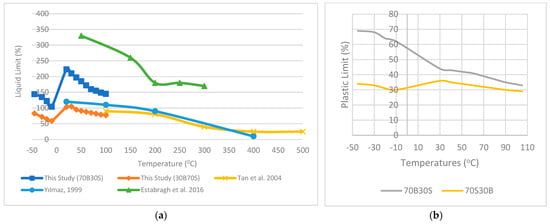
Figure 6.
(a,b) Changes in temperature-dependent consistency limits (Yılmaz, 1999 [64]; Tan et al., 2004 [65]; Estabragh et al., 2016 [63].
3.2. Shear Box Experiment Findings
Knowledge of the shear properties of the soil and the influence of temperature on these properties is of central importance for geotechnical planning in order to ensure the integrity of underground structures that are exposed to thermal loads and temperature fluctuations. This importance arises from the fact that the mechanical performance of c and Φ significantly affects the bearing capacity of foundations. That is why, after the samples were cured without curring and under thermal conditions for 48–24 h, the shear box test was performed, and the soil values c and Φ were determined (Table 4 and Table 5, Figure 7 and Figure 8). If we discuss the results of the shear box experiments performed on BSM at various temperatures from −45 °C to +105 °C, it will be possible to make an evaluation as follows:

Table 4.
Shear box experiment values without thermal conditions.

Table 5.
Shear box experiment values under thermal conditions.
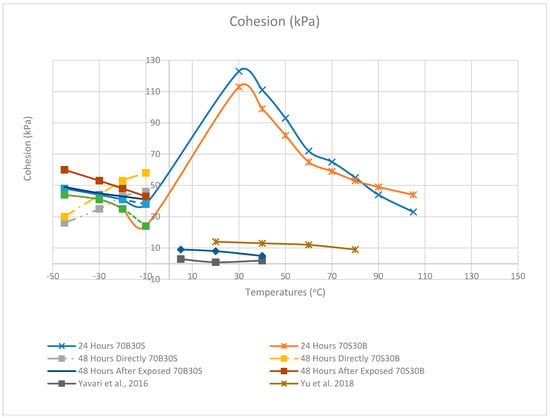
Figure 7.
Comparative graph of the c values in previous studies in the literature with the c values obtained in various curing results in this study (Yavari et al., 2016 [40]; Yu et al., 2018 [45]).
- The cohesion values decreased as temperatures increased, with approximately a 61% decrease for 70S30B and a 73% decrease for 70B30S. The Φ values also generally decreased as the temperature rose, but the change was not linear. There was approximately a 77% decrease between +30 °C and +105 °C for the sand-dominant mixture and a 73% decrease for the high bentonite content mixture. Both mixtures showed decreased cohesion values and shear strength with increasing temperatures, with a greater decline observed in the high-bentonite mixtures. The Φ values decreased with higher temperatures in both mixtures, with the high sand samples experiencing more pronounced decreases compared to the high bentonite samples.
- After a 24 h exposure to freezing conditions, the c values and shear strength increased with decreasing temperature, along with an increase in Φ values. After a 48 h exposure to freezing conditions, c values and shear strength still increased with lower temperatures, but Φ values decreased (Figure 7).
As a result, Temperature had a significant impact on the cohesion and shear strength, generally causing a decrease with higher temperatures. The Φ values showed variations with temperature, but a general trend of decrease was observed. These findings show that there is a relationship between temperature and the mechanical properties of soils that vary depending on the temperature exposed, mixture compositions, and exposure times. The observed changes in soil cohesion under thermal conditions may be partially explained by the redistribution of particles and water migration, consistent with the transport dynamics described by Ding et al. [66]. Furthermore, the role of microstructural rearrangements in influencing mechanical properties, as emphasized by Chen et al. [67], provides additional insights into the mechanisms driving these changes.”
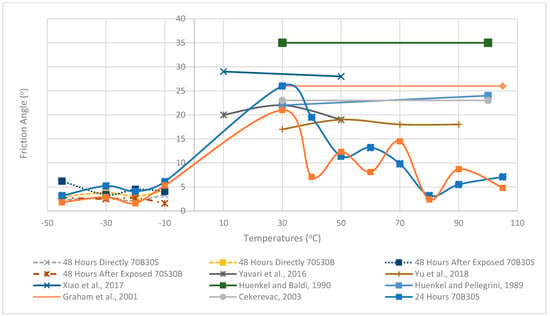
Figure 8.
Comparative graph of the c values in previous studies in the literature with the Φ values obtained in various curing results in this study (Huenkel and Baldi, 1990 [48]; Huenkel and Pellegrini, 1989 [47]; Graham et al., 2001 [49]; Yavari et al., 2016 [40]; Xiao et al., 2017 [46]; Yu et al., 2018 [45]; Cekerevac, 2003 [68]).
The results depicted in Figure 8 indicate that temperature fluctuations do not exhibit a linear impact on Φ. Given that particle size and shape primarily determine Φ, temperature variations have minimal influence on these factors. However, soil cohesion is influenced by the pliability of fine soils and the interaction between water and clay particles. The data presented in the tables suggest that temperature fluctuations affect these characteristics (Figure 8). Consequently, as temperature increases, particle cohesion, and shear resistance decrease. Conversely, it has been observed that freezing enhances cohesion and shear resistance in the samples tested immediately after a 24 h exposure period, while cohesion values and shear resistance decrease for the samples tested after a 48 h exposure period. Furthermore, decreased temperatures lead to increased cohesion and shear resistance in thawed samples from both exposure periods (24 h and 48 h). This phenomenon may stem from particle reorganization following exposure periods, resulting in a more robust structure, thereby manifesting as an increase in shear parameters.
Researchers have studied the effects of temperature conditions on Φ of clay and revealed that this effect is negligible [40,48,69,70,71]. These results are consistent with the findings presented in Figure 8, showing that Φ is independent of thermal conditions. On the other hand, studies by Yu et al. [45] and Yavari et al. [40] examined the effects of temperature changes on clay soil cohesion in detail (Figure 7). Yavari et al. [40] stated that increasing temperature (5–40 °C) in kaolin clay can lead to both an increase and a decrease in cohesion. However, a decrease in cohesion was observed at the end of the heating process. In contrast, Yu et al. [45] reported that the cohesion of Boom clay decreased significantly with increasing temperature from 20 °C to 80 °C. In evaluating these findings, it is important to consider factors such as the test equipment used, materials, and thermal gradient. Literature reviews show that temperature increase does not have a significant effect on Φ. The plasticity property of fine-grained soils is of critical importance for cohesion. However, the interaction between water and clay particles creates a greater effect, especially with factors such as layer thickness and viscous shear strength between clay minerals. It is thought that increasing temperature changes these properties and reduces cohesion by reducing the viscous shear strength between clay minerals. In addition, it has been observed that decreasing temperature changes increase cohesion and shear resistance. It is thought that this improvement is due to the formation of a more solid structure by rearranging the particles after freezing conditions.
Permafrostcovers approximately 25% of the Earth’s surface [72]. However, comprehensive scientific research on the mechanical properties of permafrost soils under different stress conditions is limited. Engineering problems related to permafrost soils arise not only in regions with permafrost events but also in areas where temperatures seasonally drop below freezing. Ice present in soil greatly affects the mechanical properties of permafrost soil, and understanding this behavior is critical for engineering designs. Butkovich [73] showed that the strength of ice increases as the temperature decreases in tests conducted on natural and artificial ice at temperatures between 0 °C and −50 °C. Similarly, the strength of permafrost soils has been confirmed by various researchers as it increases with decreasing temperature [74,75,76]. Anderson and Hoekstra [77] reported that the engineering properties of such soils, especially between 0 °C and “It has been suggested that it is significantly affected in the temperature range of 10 °C.” According to Tsytovich [76], the reason for the temperature fluctuation in strength is that when the temperature drops, the mobility of hydrogen atoms inside the ice structure is limited, increasing strength.
3.3. Swelling Pressure
When soil is subjected to thermal loads and temperature changes, the safety of engineering structures located on these soils can be seriously affected. Therefore, a detailed understanding of the swelling properties of soils and the effect of temperature changes on these properties is of critical importance. In this study, the constant volume method was used to evaluate the effects of different temperature conditions on the swelling pressure of soils. Table 6 and Figure 9 present the results of the experimental studies conducted at laboratory temperature (20–24 °C) representing the standard air conditions of the geotechnical laboratory where the study was conducted for the mixtures 70B30S and 70S30B, without considering the effects of thermal changes. These results allow the comparison of the swelling behavior of different soil mixtures and provide a basis for better understanding the effect of thermal conditions.

Table 6.
Swelling pressure values of the mixture soil without thermal conditions.
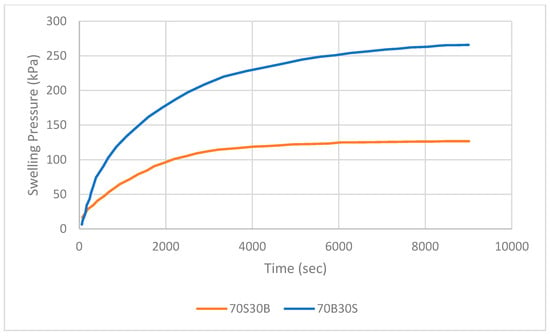
Figure 9.
Swelling pressure graph of the mixture soil without thermal conditions.
The results obtained from the swelling pressure tests show that there are significant changes in the swelling properties of bentonite–sand mixtures (BSMs) in the temperature range between 30 °C and 105 °C. These changes, which are visually expressed in Figure 10, Figure 11 and Figure 12, reveal the main differences in the mechanical responses of the two different mixtures against temperature. In particular, the bentonite-dominated 70B30S mixture exhibited a significant increase in the swelling pressure values as the temperature increased and this increase was measured to be approximately ±168%. This can be explained by the high water retention capacity of bentonite and the fact that heat causes the water in the intermolecular spaces to expand. On the other hand, the swelling values decreased by approximately ±51% with increasing temperature in the sand-dominated 70S30B mixture. This decrease in sand-dominated mixtures can be attributed to the low water-holding capacity of sand and less thermal sensitivity. Similarly, the experiments conducted in the temperature range between −45 °C and −10 °C revealed a reverse trend in the swelling values of these mixtures. Under cold temperature conditions, the swelling values of the 70B30S mixture increased by about 56% as the temperature decreased. This increase can be attributed to the crystallization of water between the clay particles at low temperatures and the widening of the distance between the particles. On the other hand, the swelling values of the 70S30B mixture decreased by about 46% in the same temperature range and this was explained by the low plasticity properties of the sand.
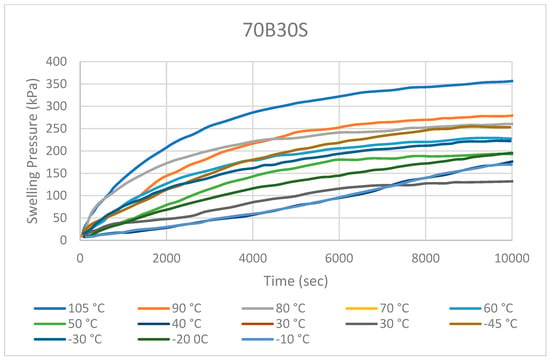
Figure 10.
The swelling values of the 70B30S under heating conditions with time.
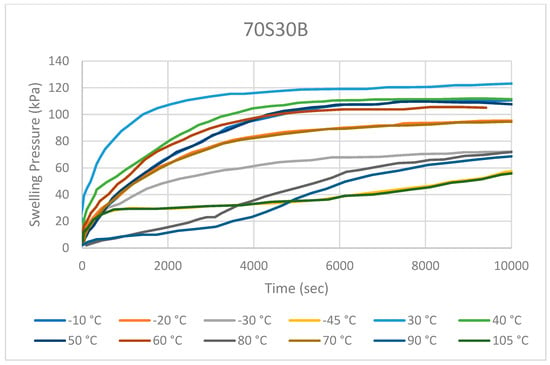
Figure 11.
The swelling values of the 70S30B under heating conditions with time.
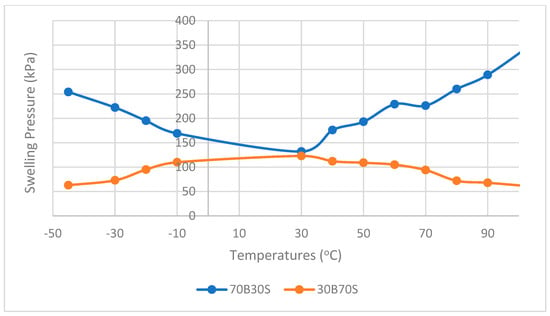
Figure 12.
Comparison of swelling pressures with various study findings.
3.4. XRD Analysis Findings
In this study, the effect of temperature change on the mechanical and physical properties of soils was investigated. The temperature-induced change in the microstructure of clay minerals has an irreversible effect on the cation exchange capacity and permeability of the clay microstructure (Ouhadi et al., 2010 [78]). The soils exposed to different temperature conditions were subjected to an XRD analysis to elucidate the underlying causes and effects (see Figure 13a,b). However, in this study, this effect was not clearly observed in the microstructure; this may be due to the low temperature difference applied during the experiment. In order to detect more significant changes, it may be necessary to extend the investigated temperature ranges. In addition, clay minerals usually require extreme thermal changes to show significant structural changes since their layered crystal structures are relatively stable under moderate heating. Studies have shown that temperatures exceeding 150 °C are usually required to cause significant changes in the basal range or interlayer water of clay minerals; the limiting data in the study are sufficient to explain the limited microstructural changes to be observed.
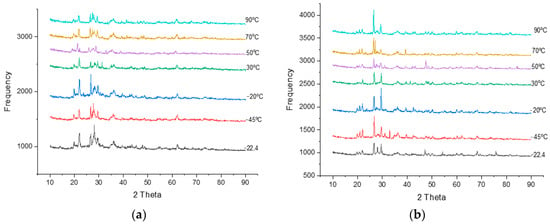
Figure 13.
XRD analysis of 70B30S after thermal exposure (a), XRD analysis of 70S30B bentonite after thermal exposure (b).
4. Conclusions and Recommendations
The primary findings derived from this study, which sought to explore alterations in the physical and mechanical characteristics of bentonite–sand blends under thermal exposure to varying temperatures, are outlined as follows.
The results obtained from the consistency limit tests showed that the LL and PL values declined with rising temperature. This decrease was more evident in mixtures rich in bentonite than in those dominated by sand. This situation may be attributed to particle expansion with temperature rise, related to the cohesive framework of clay minerals. On the other hand, an increase was observed in the LL and plastic limit values under freezing conditions and this increase became more pronounced, especially in the sand-rich mixtures. This phenomenon can be explained by the accumulation of fine particles and the fragmentation of coarse particles.
The results obtained from the direct shear tests indicated that the Φ did not exhibit a linear response to temperature variations. However, it was determined that increasing temperature led to a reduction in cohesion within the bentonite-dominant mixtures, and this effect became more evident in the sand-rich blends. In addition, the findings showed that temperature variations considerably altered the plasticity and cohesion behavior of fine-grained soils by influencing the interaction between clay particles and pore water. This condition was attributed to the reduction in water viscosity and the weakening of electrostatic forces as the temperature increased. Furthermore, the data revealed that the impact of temperature on soil cohesion is largely associated with the plastic characteristics of fine-grained soils and their interaction with water. As temperature rose, cohesion and shear strength decreased in both mixtures; however, the decline was more pronounced in sand-dominant specimens. Similarly, Φ decreased with increasing temperature in both mixtures, with a steeper reduction observed in the sand-rich samples.
The change in cohesion values is greater for sand-rich mixtures compared with those containing higher bentonite levels. The samples evaluated immediately after the 24–48 h exposure period and the samples evaluated after 24 h of dissolution showed these differences. After 48 h of dissolution, the change in the cohesion values became more pronounced in the samples with high bentonite content compared to the samples with high sand content. On the other hand, after 24 h of exposure, both direct and post-dissolution cohesion changes became more evident in bentonite-rich specimens relative to the sand-dominant ones. However, in the 48 h dissolution measurements, this change became more pronounced in the samples with high bentonite content.
As a result, since Φ is primarily controlled by the size and geometry of particles, it is less affected by temperature changes. However, the cohesion of fine-grained soils, influenced by the interaction of clay minerals with water, was significantly affected by temperature fluctuations. The cohesion values decreased as the temperature increased for both mixtures, and this decrease was more pronounced in sand-rich mixtures compared to those with higher bentonite content. Similarly, Φ declined as temperature rose in both mixtures; however, a more remarkable decrease was observed in samples with high sand content. The results revealed that as the temperature increased from 20 °C to 105 °C, the cohesion (c) of the 70B30S and 70S30B mixtures decreased by approximately 73% and 61%, respectively. Similarly, Φ decreased by 77% in the sand-dominated mixtures and 73% in the bentonite-dominated mixtures. However, the swelling pressures increased by 168% in the bentonite-rich samples and decreased by 51% in the sand-rich samples under the same temperature conditions.
Finally, the results obtained from the swelling pressure tests performed at varying temperature levels. While the temperature increase increased the swelling pressure values in mixtures rich in bentonite, an inverse relationship was observed in sand-dominant specimens; swelling pressure values decreased as the temperature increased. In contrast, under freezing conditions, swelling pressure rose in bentonite-rich mixtures, while a decline was observed in sand-rich mixtures. This study was conducted on bentonite–sand mixtures mixed at different levels to model the behavior of clay and sand soils. The results provide a basis for understanding the thermal behavior of soils in general; however, future research should be extended to simulate more severe environmental conditions by investigating the effects of more extreme temperature ranges beyond those studied here, specific to different soil types. Additionally, studies that consider different soil compositions under these conditions, as well as initial water contents and more exposure times and cycles, could provide deeper insights into the thermal and mechanical response of soils and further expand the applicability of these findings to various geotechnical scenarios.
Author Contributions
Conceptualization, İ.K.; Methodology, İ.K., A.N. and A.H.V.; Software, İ.K. and A.N.; Validation, İ.K.; Formal analysis, İ.K. and A.H.V.; Investigation, İ.K. and A.N.; Resources, İ.K.; Data curation, İ.K. and A.N.; Writing—original draft, İ.K., A.N. and A.H.V.; Writing—review & editing, İ.K. and S.K. All authors have read and agreed to the published version of the manuscript.
Funding
This research was funded by Karabük University under grant number KBÜBAP-22-YL-022.
Institutional Review Board Statement
The study did not require ethical approval.
Informed Consent Statement
Not applicable.
Data Availability Statement
Data is contained within the article.
Acknowledgments
The authors of this study thank you, Karabük University, for the support provided under grant number KBÜBAP-22-YL-022.
Conflicts of Interest
The authors declare no conflict of interest.
References
- Dupray, F.; François, B.; Laloui, L. Analysis of the FEBEX Multi-Barrier System Including Thermoplasticity of Unsaturated Bentonite. Int. J. Numer. Anal. Methods Geomech. 2013, 37, 399–422. [Google Scholar] [CrossRef]
- Ausseur, J.Y.; Sauty, J.P. Thermal Exploitation of Shallow Aquifers. Guide for the Preparation of Preliminary Studies of Technical Feasibility (INIS-FR--16-0158). France. 1982. Available online: https://www.osti.gov/etdeweb/biblio/22448274 (accessed on 28 December 2024).
- Bourne-Webb, P.; Burlon, S.; Javed, S.; Kürten, S.; Loveridge, F. Analysis and Design Methods for Energy Geostructures. Renew. Sustain. Energy Rev. 2016, 65, 402–419. [Google Scholar] [CrossRef]
- Ocłoń, P.; Bittelli, M.; Cisek, P.; Kroener, E.; Pilarczyk, M.; Taler, D.; Rao, R.V.; Vallati, A. The Performance Analysis of a New Thermal Backfill Material for Underground Power Cable System. Appl. Therm. Eng. 2016, 108, 233–250. [Google Scholar] [CrossRef]
- Ochsner, K. Carbon Dioxide Heat Pipe in Conjunction with a Ground Source Heat Pump (GSHP). Appl. Therm. Eng. 2008, 28, 2077–2082. [Google Scholar] [CrossRef]
- Li, Z.; Liu, L.; Yan, S.; Zhang, M.; Xia, J.; Xie, Y. Effect of Freeze-Thaw Cycles on Mechanical and Porosity Properties of Recycled Construction Waste Mixtures. Constr. Build. Mater. 2019, 210, 347–363. [Google Scholar] [CrossRef]
- Helms, D. Readings in the History of the Soil Conservation Service. Soil. Conserv. Serv. 1991, 16, 24–28. [Google Scholar]
- Campanella, R.G.; Mitchell, J.K. Influence of Temperature Variations on Soil Behavior. J. Soil Mech. Found. Div. 1968, 94, 709–734. [Google Scholar] [CrossRef]
- Towhata, I.; Kuntiwattanaku, P.; Seko, I.; Ohishi, K. Volume Change of Clays Induced by Heating as Observed in Consolidation Tests. Soils Found. 1993, 33, 170–183. [Google Scholar] [CrossRef] [PubMed]
- Houston, S.L.; Lin, H. Da A Thermal Consolidation Model for Pelagic Clays. Mar. Geotechnol. 2008, 7, 79–98. [Google Scholar] [CrossRef]
- Cabalar, A.F.; Clayton, C. Effect of Temperature on Triaxial Behavior of a Sand with Disaccharide. Period. Polytech. Civ. Eng. 2016, 60, 603–609. [Google Scholar] [CrossRef][Green Version]
- Qiu, P.; Tang, L.; Zheng, J.; Wang, W.; Li, Y.; Li, G.; Jin, L.; Yu, Y.; Duan, X. Experimental Investigations on the Shear Strength and Creep Properties of Soil-Rock Mixture under Freeze-Thaw Cycles. Cold Reg. Sci. Technol. 2024, 217, 104037. [Google Scholar] [CrossRef]
- Zhang, X.; Huang, A.; Guan, J.; Zhang, W.; Sun, B. Influence of Frozen Soil Site Conditions on Ground Motion Characteristics in Cold Regions. Cold Reg. Sci. Technol. 2023, 217, 104019. [Google Scholar] [CrossRef]
- Alonso, E.E.; Romero, E.; Hoffmann, C.; García-Escudero, E. Expansive Bentonite-Sand Mixtures in Cyclic Controlled-Suction Drying and Wetting. Eng. Geol. 2005, 81, 213–226. [Google Scholar] [CrossRef]
- Nowamooz, H.; Masrouri, F. Hydromechanical Behaviour of an Expansive Bentonite/Silt Mixture in Cyclic Suction-Controlled Drying and Wetting Tests. Eng. Geol. 2008, 101, 154–164. [Google Scholar] [CrossRef]
- Ma, Q.; Shu, H.; Xiao, H.; Huang, C. Temperature-Controlled Triaxial Compression Test of Tire Strip-Reinforced Silty Clay. Arab. J. Sci. Eng. 2020, 45, 4247–4256. [Google Scholar] [CrossRef]
- Yan, Y.; Chang, D.; Liu, J.; Xu, A.; Zhang, M.; Xie, Y. Design and Validation of a New Temperature-Controlled Large-Scale Direct Shear Apparatus. Cold Reg. Sci. Technol. 2023, 216, 103992. [Google Scholar] [CrossRef]
- Hoseinimighani, H.; Szendefy, J. A Review on Effect of Temperature Change on Mechanical Parameters of Fine Soils. Period. Polytech. Civ. Eng. 2021, 65, 825–839. [Google Scholar] [CrossRef]
- Cui, Y.J.; Yahia-Aissa, M.; Delage, P. A Model for the Volume Change Behaviour of Heavily Compacted Swelling Clays. Eng. Geol. 2002, 64, 233–250. [Google Scholar] [CrossRef]
- Cuisinier, O.; Masrouri, F. Hydromechanical Behaviour of a Compacted Swelling Soil over a Wide Suction Range. Eng. Geol. 2005, 81, 204–212. [Google Scholar] [CrossRef]
- Lloret, A.; Villar, M.V.; Sánchez, M.; Gens, A.; Pintado, X.; Alonso, E.E. Mechanical Behaviour of Heavily Compacted Bentonite under High Suction Changes. Géotechnique 2003, 53, 27–40. [Google Scholar] [CrossRef]
- Azhar, M.; Mondal, S.; Tang, A.M.; Singh, A.K. Effect of Temperature on the Mechanical Properties of Fine-Grained Soils—A Review. Geothermics 2024, 116, 102863. [Google Scholar] [CrossRef]
- Taleb Bahmed, I.; Harichane, K.; Ghrici, M.; Boukhatem, B.; Rebouh, R.; Gadouri, H. Prediction of Geotechnical Properties of Clayey Soils Stabilised with Lime Using Artificial Neural Networks (ANNs). Int. J. Geotech. Eng. 2019, 13, 191–203. [Google Scholar] [CrossRef]
- Carrière, S.R.; Jongmans, D.; Chambon, G.; Bièvre, G.; Lanson, B.; Bertello, L.; Berti, M.; Jaboyedoff, M.; Malet, J.P.; Chambers, J.E. Rheological Properties of Clayey Soils Originating from Flow-like Landslides. Landslides 2018, 15, 1615–1630. [Google Scholar] [CrossRef]
- Liu, B.; Zhu, C.; Tang, C.S.; Xie, Y.H.; Yin, L.Y.; Cheng, Q.; Shi, B. Bio-Remediation of Desiccation Cracking in Clayey Soils through Microbially Induced Calcite Precipitation (MICP). Eng. Geol. 2020, 264, 105389. [Google Scholar] [CrossRef]
- Rodríguez, M.A. Anticipated Degradation Modes of Metallic Engineered Barriers for High-Level Nuclear Waste Repositories. Jom 2014, 66, 503–525. [Google Scholar] [CrossRef]
- Poinssot, C.; Gin, S. Long-Term Behavior Science: The Cornerstone Approach for Reliably Assessing the Long-Term Performance of Nuclear Waste. J. Nucl. Mater. 2012, 420, 182–192. [Google Scholar] [CrossRef]
- Kim, J.S.; Kwon, S.K.; Sanchez, M.; Cho, G.C. Geological Storage of High Level Nuclear Waste. KSCE J. Civ. Eng. 2011, 15, 721–737. [Google Scholar] [CrossRef]
- Guo, X.; Gin, S.; Frankel, G.S. Review of Corrosion Interactions between Different Materials Relevant to Disposal of High-Level Nuclear Waste. Npj Mater. Degrad. 2020, 4, 34. [Google Scholar] [CrossRef]
- Güllü, H.; Khudir, A. Effect of Freeze-Thaw Cycles on Unconfined Compressive Strength of Fine-Grained Soil Treated with Jute Fiber, Steel Fiber and Lime. Cold Reg. Sci. Technol. 2014, 106–107, 55–65. [Google Scholar] [CrossRef]
- Gharemahmudli, S.; Sadeghi, S.H.; Najafinejad, A.; Darki, B.Z.; Kheirfam, H.; Behbahani, A.M. Effect of a Freezing-thawing Cycle on Overall and Inter-variability of Runoff and Soil Loss Components for a Loess Soil. Preprint, 2021. [Google Scholar] [CrossRef]
- Xie, S.; Qu, J.; Lai, Y.; Zhou, Z.; Xu, X. XEffects of freeze-thaw cycles on soil mechanical and physical properties in the Qinghai-Tibet Plateau. J. Mt. Sci. 2015, 12, 999–1009. [Google Scholar] [CrossRef]
- Viklander, P.; Eigenbrod, D. Stone Movements and Permeability Changes in till Caused by Freezing and Thawing. Cold Reg. Sci. Technol. 2000, 31, 151–162. [Google Scholar] [CrossRef]
- Brandl, H. Energy Foundations and Other Thermo-Active Ground Structures. Géotechnique 2015, 56, 81–122. [Google Scholar] [CrossRef]
- Scaringi, G.; Loche, M. A Thermo-Hydro-Mechanical Approach to Soil Slope Stability under Climate Change. Geomorphology 2022, 401, 108108. [Google Scholar] [CrossRef]
- Shibasaki, T.; Matsuura, S.; Okamoto, T. Experimental Evidence for Shallow, Slow-Moving Landslides Activated by a Decrease in Ground Temperature. Geophys. Res. Lett. 2016, 43, 6975–6984. [Google Scholar] [CrossRef]
- Leroueil, S. Natural Slopes and Cuts: Movement and Failure Mechanisms. Geotechnique 2001, 51, 197–243. [Google Scholar] [CrossRef]
- Di Donna, A.; Ferrari, A.; Laloui, L. Experimental Investigations of the Soil–Concrete Interface: Physical Mechanisms, Cyclic Mobilization, and Behaviour at Different Temperatures. Can. Geotech. J. 2016, 53, 659–672. [Google Scholar] [CrossRef]
- Yazdani, S.; Helwany, S.; Olgun, G. Influence of Temperature on Soil-Pile Interface Shear Strength. Geomech. Energy Environ. 2019, 18, 69–78. [Google Scholar] [CrossRef]
- Yavari, N.; Tang, A.M.; Pereira, J.-M.; Hassen, G. Effect of Temperature on the Shear Strength of Soils and the Soil–Structure Interface. Can. Geotech. J. 2016, 53, 1186–1194. [Google Scholar] [CrossRef]
- Cekerevac, C.; Laloui, L. Experimental analysis of the cyclic behaviour of kaolin at high temperature. Géotechnique 2004, 60, 651–655. [Google Scholar] [CrossRef]
- Abuel-Naga, H.M.; Bergado, D.T.; Bouazza, A.; Pender, M.J. Thermal Conductivity of Soft Bangkok Clay from Laboratory and Field Measurements. Eng. Geol. 2009, 105, 211–219. [Google Scholar] [CrossRef]
- Zhang, C.L.; Conil, N.; Armand, G. Thermal Effects on Clay Rocks for Deep Disposal of High-Level Radioactive Waste. J. Rock Mech. Geotech. Eng. 2017, 9, 463–478. [Google Scholar] [CrossRef]
- Zhang, L.; Ren, F.; Li, H.; Cheng, D.; Sun, B. The Influence Mechanism of Freeze-Thaw on Soil Erosion: A Review. Water 2021, 13, 1010. [Google Scholar] [CrossRef]
- Yu, H.; Chen, W.; Gong, Z.; Ma, Y.; Chen, G.; Li, X. Influence of Temperature on the Hydro-Mechanical Behavior of Boom Clay. Int. J. Rock Mech. Min. Sci. 2018, 108, 189–197. [Google Scholar] [CrossRef]
- Xiao, S.; Suleiman, M.T.; Elzeiny, R.; Xie, H.; Al-Khawaja, M. Soil-Concrete Interface Properties Subjected to Temperature Changes and Cycles Using Direct Shear Tests. In Geotechnical Frontiers 2017: Geotechnical Materials, Modeling, and Testing; American Society of Civil Engineers: Orlando, FL, USA, 2017; pp. 175–183. [Google Scholar] [CrossRef]
- Hueckel, T.; Pellegrini, R. Modeling of thermal failure of saturated clays. In Proceedings of the International Symposium on Numerical Models in Geomechanics, NUMOG, Niagara Falls, ON, Canada, 8–11 May 1989; pp. 81–90. [Google Scholar]
- Hueckel, T.; Baldi, G. Thermoplasticity of Saturated Clays: Experimental Constitutive Study. J. Geotech. Eng. 1990, 116, 1778–1796. [Google Scholar] [CrossRef]
- Graham, J.; Tanaka, N.; Crilly, T.; Alfaro, M. Modified Cam-Clay modelling of temperature effects in clays. Can. Geotech. J. 2001, 38, 608–621. [Google Scholar] [CrossRef]
- Morin, R.; Silva, A.J. The Effects of High Pressure and High Temperature on Some Physical Properties of Ocean Sediments. J. Geophys. Res. 1984, 89, 511–526. [Google Scholar] [CrossRef]
- Sultan, N.; Delage, P.; Cui, Y.J. Temperature Effects on the Volume Change Behaviour of Boom Clay. Eng. Geol. 2002, 64, 135–145. [Google Scholar] [CrossRef]
- Youssef, M.S.; El Ramli, A.H.; El Demery, M. Relationships between shear strength, consolidation, liquid limit and plastic limit for remoulded clays. In Proceedings of the 6th International Conference on Soil Mechanical, Montreal, QC, Canada, 8–15 September 1965; pp. 126–129. [Google Scholar]
- Ctori, P. The Effects of Temperature on the Physical Properties of Cohesive Soil. Ground Eng. 1989, 22, 62–73. [Google Scholar]
- Beles, A.A.; Stanculescu, I.I. Thermal Treatment as a Means of Improving the Stability of Earth Masses. Geotechnique 1958, 8, 158–165. [Google Scholar] [CrossRef]
- Hamisi, H.; Park, S.E.; Choi, B.H.; An, Y.T.; Lee, J. Influence of firing temperature on physical properties of same clay and pugu kaolin for ceramic tiles application. Int. J. Mater. Sci. Appl. 2014, 3, 143–146. [Google Scholar] [CrossRef][Green Version]
- Kuntiwattanakul, P.; Towhata, I.; Ohishi, K.; Seko, I. Temperature Effects on Undrained Shear Characteristics of Clay. Soils Found. 1995, 35, 147–162. [Google Scholar] [CrossRef]
- Zhang, M.; Zhang, H.; Cui, S.; Jia, L.; Zhou, L.; Chen, H. Engineering Properties of GMZ Bentonite-Sand as Buffer/Backfilling Material for High-Level Waste Disposal. Eur. J. Environ. Civ. Eng. 2012, 16, 1216–1237. [Google Scholar] [CrossRef]
- Yu, W.B.; Lai, Y.M.; Sun, Z.Z.; Jin, H.J.; Zhang, X.F. Experimental Studies on the Ripped-Rock Revetment Embankment in Permafrost Regions of the Qinghai-Tibet Railroad. Cold Reg. Sci. Technol. 2006, 45, 1–7. [Google Scholar] [CrossRef]
- Akinwunmi, B.; Sun, L.; Hirvi, J.T.; Kasa, S.; Pakkanen, T.A. Influence of Temperature on the Swelling Pressure of Bentonite Clay. Chem. Phys. 2019, 516, 177–181. [Google Scholar] [CrossRef]
- Kale, R.C.; Ravi, K. Influence of Thermal Loading on Index and Physicochemical Properties of Barmer Bentonite. Appl. Clay Sci. 2018, 165, 22–39. [Google Scholar] [CrossRef]
- Yilmaz, G. The Effects of Temperature on the Characteristics of Kaolinite and Bentonite. Sci. Res. Essays 2011, 6, 1928–1939. [Google Scholar] [CrossRef]
- Jefferson, I.; Rogers, C.D.F. Liquid Limit and the Temperature Sensitivity of Clays. Eng. Geol. 1998, 49, 95–109. [Google Scholar] [CrossRef]
- Estabragh, A.R.; Khosravi, F.; Javadi, A.A. Effect of Thermal History on the Properties of Bentonite. Environ. Earth Sci. 2016, 75, 657. [Google Scholar] [CrossRef]
- Yılmaz, G. The Effect of Heating on Engineering Properties of Kaolinite and Bentonite. In Proceedings of the National Clay Symposium, Istanbul, Turkey, 15–18 September 1999; Volume 9, pp. 225–232. [Google Scholar]
- Tan, Ö.; Yılmaz, L.; Zaimoğlu, A.S. Variation of some engineering properties of clays with heat treatment. Mater. Lett. 2004, 58, 1176–1179. [Google Scholar] [CrossRef]
- Ding, X.H.; Luo, B.; Zhou, H.T.; Chen, Y.H. Generalized Solutions for Advection–Dispersion Transport Equations Subject to Time- and Space-Dependent Internal and Boundary Sources. Comput. Geotech. 2025, 178, 106944. [Google Scholar] [CrossRef]
- Chen, Y.; Zhang, L.; Chen, Z.; Liu, Z.; Luo, B.; Ding, X.; Xu, L.; Deng, Z.; Lu, Z. Analysis of Triaxial Shear Properties of Mudstone Coarse-Grained Soils Considering Penetrating Erosion Effects. Transp. Geotech. 2025, 50, 101469. [Google Scholar] [CrossRef]
- Cekerevac, C. Thermal Effects on the Mechanical Behaviour of Saturated Clays. Ph.D. Thesis, École Polytechnique Fédérale de Lausanne, Lausanne, Switzerland, 2003. [Google Scholar]
- Baldi, G.; Hueckel, T.; Pellegrini, R. Thermal Volume Changes of the Mineral–Water System in Low-Porosity Clay Soils. Can. Geotech. J. 2011, 25, 807–825. [Google Scholar] [CrossRef]
- Liu, L.; Cai, G.; Liu, X.; Liu, S.; Puppala, A.J. Evaluation of Thermal-Mechanical Properties of Quartz Sand–Bentonite–Carbon Fiber Mixtures as the Borehole Backfilling Material in Ground Source Heat Pump. Energy Build. 2019, 202, 109407. [Google Scholar] [CrossRef]
- Cekerevac, C.; Laloui, L. Experimental Study of Thermal Effects on the Mechanical Behaviour of a Clay. Int. J. Numer. Anal. Methods Geomech. 2004, 28, 209–228. [Google Scholar] [CrossRef]
- Oliva, M.; Fritz, M. Erratum to “Permafrost Degradation in a Warmer Earth: Challenges and Perspectives”, [Curr Opin Environ Sci Health, Volume 5, October 2018, Pages 14–18]. Curr. Opin. Environ. Sci. Health 2018, 20, 100231. [Google Scholar] [CrossRef]
- Butkovich, T.R. Ultimate Strength of Ice. Cold Reg. Sci. Technol. 1954, 9, 12. [Google Scholar] [CrossRef]
- Neuber, H.; Waiters, R. Zum Mechanischen Verhalten Gefrorener Lockergesteine Bei Dreiaxialer Druckbelastung. Geolog. Landesamt Nordrh.-Westfal. 1970, 18, 79–87. [Google Scholar]
- Heiner Umdreh’n Orpheus! Arid. Land. Res. Manag. 2021, 35, 311–329. [CrossRef]
- Tsytovich, N.A. Physical Phenomena and Processes in Freezing, Frozen and Thawing Soils; no. NRC-TT-1164; National Research Council of Canada: Ottawa, ON, Canada, 1963; 109p. [Google Scholar] [CrossRef]
- Anderson, D.M.; Hoekstra, P. Migration of Interlamellar Water During Freezing and Thawing of Wyoming Bentonite1. Soil Sci. Soc. Am. J. 1965, 29, 498. [Google Scholar] [CrossRef]
- Ouhadi, V.R.; Yong, R.N.; Goodarzi, A.R.; Safari-Zanjani, M. Effect of temperature on the re-structuring of the microstructure and geo-environmental behaviour of smectite. Appl. Clay Sci. 2010, 47, 2–9. [Google Scholar] [CrossRef]
Disclaimer/Publisher’s Note: The statements, opinions and data contained in all publications are solely those of the individual author(s) and contributor(s) and not of MDPI and/or the editor(s). MDPI and/or the editor(s) disclaim responsibility for any injury to people or property resulting from any ideas, methods, instructions or products referred to in the content. |
© 2025 by the authors. Licensee MDPI, Basel, Switzerland. This article is an open access article distributed under the terms and conditions of the Creative Commons Attribution (CC BY) license (https://creativecommons.org/licenses/by/4.0/).